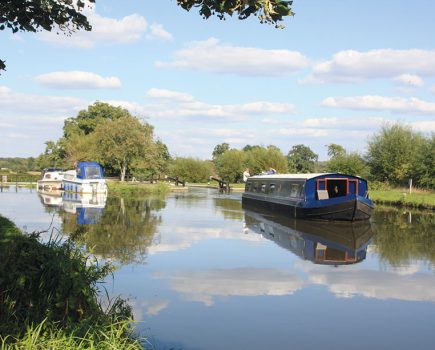The look so gentle and they represent the tranquility of a waterside scene to many, but Speckled Wood butterflies are always prepared to do battle, explains Pip Webster
Butterflies seem such delicate creatures, but the aerial skirmishes of male Speckled Woods enliven many a saunter alongside woodland margins and hedgerows by the towpath.
Perching on a leaf in a pool of sunshine amid the dappled shade, they will attack any intruder. Two male butterflies spiral round each other, bumping and clashing wings as they ascend, until the winner returns to the same patch of sunlight, his rival ejected from his few square metres of territory.
Speckled Wood butterflies have one of the longest seasons of any British butterfly, from March to October, though individual adults seldom live longer than a week. After overwintering as either a hibernating caterpillar or chrysalis, two or three overlapping broods of adults emerge throughout the year, later broods being darker coloured.
They are unmistakable, with chocolate and cream markings and are the only ‘brown’ butterfly (a family that lay their eggs on grasses) with three small cream-ringed black and white eyespots on each hindwing and one on each forewing.

The caterpillars chomp away on mundane grass, but adults fly to the treetops during summer to drink the sweet honeydew coating the leaves. In autumn, they descend to sup nectar from flowers and – since the second brood peaks in late August or early September – they take advantage of the brambles in woodland or hedgerow, supping blackberry juices (especially when the fruit is beginning to ferment).
Butterflies have no mouth to eat so use a long straw-like proboscis to suck up juices and nectar, which they keep coiled up when they are not feeding.
They are reliant on other animals to breach the skin of the fruit. Wasps, who have stronger jaws designed for chewing wood into paper-like nest material, love blackberries, offering other insects access to the oozing juices – the ragged orange Comma, handsome Red Admiral and Speckled Wood butterflies included.
On a waterside walk, you may notice serpentine-like white tracks on the bramble leaves. These are formed by the caterpillars of pygmy moths (Nepticula aurella), one of a number of insect larvae that live within the leaves, tunnelling between the upper and lower layers. The track gets wider as the caterpillars grow.
Our ancestors used a concoction of boiled bramble leaves, with added ingredients, as a lotion and for fastening teeth back in!
Brambles produce long, thorny, arching shoots that root easily where they reach the ground, and flower in the second year of growth. The strong, backward-pointing thorns enable the plant to scramble through vegetation and make it difficult to detach from other plants or clothes. In parts of England the stems are called ‘lawyers’ because, ‘when they get a hold on you, you don’t easily get rid of them’.
The bramble usually flowers in July and August and the blackberries, ripening from mid-August to October, provide a feast for, among others, blackbirds, chaffinches, bullfinches, starlings, robins, foxes, wood mice, and us humans. Pick the big, juicy black ones – they are delicious straight off the bramble or eaten with icing sugar and cream – but get them before the frost does.
Enjoy sharing the fruits of early autumn, but keep some for the Speckled Wood butterflies!
__________________
You may also like:
16 amazing fish species you can catch in canals and rivers
Rare eel discovered in Birmingham Canal
8 bat species to look out for on British waterways
Image(s) provided by:
Archant







